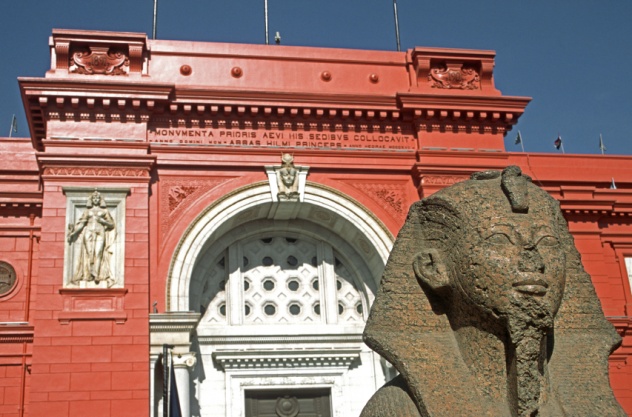 Mysteries
Mysteries  Mysteries
Mysteries  Creepy
Creepy 10 Scary Tales from the Middle Ages That’ll Keep You up at Night
 Humans
Humans 10 One-of-a-kind People the World Said Goodbye to in July 2024
 Movies and TV
Movies and TV 10 Holiday Movies Released at Odd Times of the Year
 Politics
Politics 10 Countries Where Religion and Politics Are Inseparable
 Weird Stuff
Weird Stuff 10 Freaky Times When Famous Body Parts Were Stolen
 Miscellaneous
Miscellaneous 10 Interesting Things Manufacturers Stopped Making and Why
 Gaming
Gaming 10 Funny Tutorials in Games
 History
History 10 Fascinating Little-Known Events in Mexican History
 Facts
Facts 10 Things You May Not Know about the Statue of Liberty
 Mysteries
Mysteries 10 Devastating Missing Child Cases That Remain Unsolved
 Creepy
Creepy 10 Scary Tales from the Middle Ages That’ll Keep You up at Night
 Humans
Humans 10 One-of-a-kind People the World Said Goodbye to in July 2024
Who's Behind Listverse?

Jamie Frater
Head Editor
Jamie founded Listverse due to an insatiable desire to share fascinating, obscure, and bizarre facts. He has been a guest speaker on numerous national radio and television stations and is a five time published author.
More About Us Movies and TV
Movies and TV 10 Holiday Movies Released at Odd Times of the Year
 Politics
Politics 10 Countries Where Religion and Politics Are Inseparable
 Weird Stuff
Weird Stuff 10 Freaky Times When Famous Body Parts Were Stolen
 Miscellaneous
Miscellaneous 10 Interesting Things Manufacturers Stopped Making and Why
 Gaming
Gaming 10 Funny Tutorials in Games
 History
History 10 Fascinating Little-Known Events in Mexican History
 Facts
Facts 10 Things You May Not Know about the Statue of Liberty
10 Recent And Surprising Scientific Finds From Around The World
Archaeologists and historians have seen remarkable years in 2014 and 2015. Here are 10 recent scientific and historical finds that have yielded striking and compelling new information about our ancient past.
10 Sunken Byzantine Basilica Found In Turkey
During a routine aerial inventory of historical and cultural artifacts conducted by the Bursa Metropolitan Municipality, a sunken structure was found only 2 meters (7 ft) underwater and 20 meters (70 ft) away from the shore of Lake Iznik in the well-known Roman and Byzantine town of Nicaea. Uludag University’s head of archaeology, Professor Mustafa Sahin, was shocked to find such a structure, wondering how these remains were not spotted until now.
The structure had a layout similar to the architectural plan of the nearby church of Hagia Sophia (not to be confused with the Hagia Sophia located in Istanbul), and it consisted of three naves. After studying the site, archaeologists revealed that the remains are of a fifth-century basilica that was built in memory of the Christian Saint Neophytos and that it collapsed during an earthquake that occurred in the region in AD 740. The 16-year-old saint was killed by Roman soldiers during the reign of Emperors Diocletian and Galerius, 10 years before the Edict of Milan, which permanently established toleration of Christianity within the Roman Empire. The saint became popular in the Middle Ages, especially in the local Christian Orthodox community. Interestingly, the spotting of the basilica coincided with feasts that the Orthodox church organizes every year on January 21 to commemorate Saint Neophytos.
The basilica was declared one of the top 10 discoveries of 2014 by the Archaeological Institute of America and is currently set to become an underwater museum. It can shed light on the historical and religious significance of the city of Nicaea and on the history of Christianity during the Byzantine Empire.
9 Moscow’s Oldest Road Is Uncovered

Not much is known about the early history of Moscow, so when archaeologists unearthed the oldest road ever found in the city of Moscow, it was a major breakthrough. The road was uncovered in the city’s historical Zaryadie district in September 2015. Zaryadie, located on the bank of Moskva River in downtown Moscow and adjacent to the UNESCO World Heritage sites at the Kremlin and the Red Square, is believed to be the oldest part of the city. Most of the district was demolished in the 1930s and 1940s by the Soviets to make way for several construction projects, most of which were never completed. However, excavations in the area were not launched until after the demolition of the massive Hotel Russia in 2006.
Recent excavations have uncovered several layers of wooden pavements. The upper layers are thought to date back to the 15th and 17th centuries, while the deepest ones are believed to date back to the 12th century, when the Kremlin was first established. According to Leonid Belyayev, a department head from the Russian Academy of Sciences Archaeology Institute, the road is believed to have connected the old Kremlin and a wharf on the Moscow River. Although the road is not named on historic city plans, it is mentioned in city chronicles under the name of “Velikaya,” or “The Large One.”
This find is of utmost significance to the city of Moscow (now home to as many as 12 million people), given that the first time it was mentioned was in the Russian chronicles of 1147. According to the chronicles, Prince Yury Dolgoruky, Grand Duke of Kiev, wanted to build a frontier town at the point where the Neglina and Moskva Rivers converge. However, the landowner, a boyar and high-ranking noble named Kuchka, refused to yield. Outraged by the refusal, Prince Yury killed the boyar and seized the area. The town was later renamed Muscovy (Moskva in Russian, after the local river).
8 New Species Of Dinosaur Found In Alaska
It has been popularly believed that dinosaurs lived exclusively in the tropics and jungles, so unearthing the remains of a new species of dinosaur in northern Alaska came as a shock for paleontologists. The remains were found September 2015 in a geological formation at the Prince Creek Formation excavation site in Colville River in northern Alaska.
Paleontologists revealed that the perfectly preserved fossils belong to a new species of herbivorous dinosaurs called hadrosaurs. Hadrosaurs were a type of scaly duck-billed dinosaur that roamed the North Slope of Alaska in herds and were able to endure dark months of winter. They may have experienced snow. Dubbed Ugrunaaluk kuukpikensis (for the lack of easy names), meaning “ancient grazer” in the language of the local Alaskan native Inupiaq culture, the hadrosaur grew up to 9 meters (30 ft) long, about the length of two full-sized cars parked end-to-end, and was a superb chewer, featuring hundreds of individual teeth well-suited for eating coarse vegetation.
How these dinosaurs survived in the barren, cold environment of the Alaskan Alps has baffled researchers. According to Earth sciences curator Pat Druckenmiller, there are currently three named dinosaurs documented from the North Slope, though Ugrunaaluk is by far the most complete dinosaur yet found in the Arctic or any polar region. Moreover, Gregory Erickson, professor of biological science at Florida State University, believes that such a find challenges everything we thought we knew about dinosaur physiology and supports the theory of Arctic-adapted dinosaurs living 69 million years ago in temperatures far cooler than the tropical or equatorial temperatures that most people associate with them.
Work at the excavation site is still in progress despite the frigid weather and the difficulty of accessing the area. Paleontologists estimate there are at least 13 distinct species of dinosaurs present based on the remains and on the nearby fossils of birds, small mammals, and fish. Further excavation and research could solve the mystery of how these animals lived and functioned in conditions not typically thought to be agreeable to occupation by reptilian dinosaurs.
7 Oldest And Longest Ancient Leather Manuscript Found In Egypt

Ancient manuscripts, especially ancient leather manuscripts, are extremely rare to find, and when the oldest and longest Egyptian leather manuscript surfaced in September 2015, archaeologists were in awe. After more than 70 years of being stored and forgotten in the Egyptian Museum in Cairo, the manuscript was “rediscovered” by Belgian-based Egyptologist Wael Sherbiny. The over 4,000-year-old roll measures about 2.5 meters (8 ft) long and dates from the late Old Kingdom to the early Middle Kingdom (2300–2000 BC). According to Sherbiny, the French Institute for Oriental Archaeology in Cairo purchased the manuscript from a local antiquities dealer and then donated it to the museum a couple of years before the outbreak of World War II. Sherbiny believes that, “The manuscript was probably forgotten because everyone who dealt with it after its initial discovery died during the Second World War or shortly after.”
Ancient leather manuscripts are rare finds because they disintegrate with time, especially due to the dry climate of the region, hence the significance of this find. According to historians, this roll is one of only seven such manuscripts to have survived to the present day. It’s also the only one on leather; the other six are on papyrus. Although Sherbiny had to painstakingly piece the fragments of the roll together like a jigsaw puzzle, it was still remarkably well-preserved and in exceptionally good condition. It is known that ancient Egyptian priests kept the leather rolls in the libraries of temples and reproduced copies on cheaper materials, such as papyrus, for public use. The priests recited the sacred texts during ceremonial occasions. What makes the manuscript even more significant is the fact that it is adorned with texts, drawings, religious spells, and incantations of divine and supernatural beings which predate the drawings found in the famous Book of the Dead manuscripts, which were written a millennium later.
6 ‘Flying Spider’ Species In Peru And Panama
Spiders have no known history of wings or flight, yet scientists found a spider that can “fly.” Of course, they can’t really fly, but they are able to control their falls and glide through air in the same way that skydivers do.
According to a study published in the Journal of the Royal Society Interface, researchers found this “flying” spider on Barro Colorado Island, Panama. Named Selenops banksi, or “flatties” due to their extremely flat bodies which measure around 5 centimeter (2 in) in diameter, the spider uses the movement of its overstretched forelegs to maneuver itself while gliding through the air. This is a one-of-a-kind find according to Stephen Yanoviak, the lead author of the new study and an associate professor of biology at the University of Louisville, who states that witnessing the gliding technique of these spiders shows a remarkable evolutionary adventure in the animal conquest of the air.
Before coming to their conclusion, scientists performed “drop tests.” They dropped 59 Selenops spiders from either canopy platforms or tree crowns as high as 20–25 meters (66–82 ft) above ground. Of the spiders dropped, 93 percent never made it to the ground, instead gliding back to the trunk of the tree from which they were dropped, proving that they were capable of controlling their fall, turning themselves right-side up in milliseconds and pointing their heads downward to glide. Researchers suggest that the spiders evolved this behavior to avoid predators or to save themselves from fatally striking the forest ground.
Studying how these “flatties” manage to control their falling trajectories could provide insight into the origins of animal flight as well as possible guidance for designing gliding robots.
5 Medieval Grave Under A Toppled Tree In Ireland
Men don’t grow on trees, but in this case, it seems they do. In 2015, a 215-year-old beech tree was uprooted by a fierce storm that hit the coastal town of Collooney in northwest Ireland, exposing the upper half of a human skeleton. Apparently, as the tree collapsed, it snapped the skeleton in two. Interestingly, knowing that the grave was at least 0.3 meters (1 ft) under the ground, it seems that the person who planted the tree at around the turn of the 19th century had no idea that a grave lay below.
Local archaeologists revealed that the skeleton belonged to a young man who died during the early medieval period, sometime between 1030 and 1200. The teenager was taller than the average medieval person; he stood more than 177 centimeter (5’10”) tall, indicating that he had access to a nourishing diet and came from a family with relatively high social status. However, mild spinal joint disease suggests that he was involved in physical labor from a young age.
According to archaeologist Marion Dowd of Sligo-Leitrim Archaeological Services, the man received a formal Christian burial because he was placed on his back in a traditional east-west orientation with his arms by his side. While governmental records indicate that there was once a church and graveyard in the general area, no other bones or signs of additional burials were found in the immediate vicinity of the fallen tree. The skeleton also showed evidence of two stab wounds, one to the chest and another to his left hand, showing that the teenager was trying to ward off his attacker. However, the reason behind his murder is still unknown. Once investigation is finished, the remains will be sent to the National Museum of Ireland in Dublin.
4 Ancient ‘Biblical’ City Uncovered In Jordan
With every archaeological find linked to the Bible or any sacred text comes great controversy, and the following find is no exception. In fall 2015, under a mound of dirt called Tall el-Hammam in Jordan’s Kikkar region, a team of US archaeologists from Trinity Southwest University headed by Professor Steven Collins uncovered the ruins of a rich and dominant Bronze Age city-state that they believe to be the biblical city of Sodom. According to Collins, Tall el-Hammam appeared to fit every known biblical description of Sodom. Collins and his team unearthed an impressive gold mine of ancient monumental structures and artifacts that they believe match biblical texts and scriptures describing the cities of Sodom and Gomorrah. The names of these cities are not only mentioned in the Bible but in other religious texts such as the Quran and the Torah, a fact that makes this find one of great religious significance. According to the Book of Genesis, Sodom was located on the fertile banks of the Jordan River, north of the Dead Sea, and was one of the largest of the Kikkars (meaning Jordan “Disks” or “well-watered plains” in the biblical text) and the most politically influential state in the area at the time. It was eventually destroyed by God because of the sins of its “wicked” people (sexual immorality and perversion, gang rape, mob violence, radical inhospitality).
According to Collins, the city is a monumental historical find that “will profoundly change the face of what is known about the history of the southern Jordan Valley, particularly during the Bronze Age.” However, his excavation has stirred much controversy among researchers who believe the evidence found on the site is insufficient to conclude that this ancient city is actually Sodom. They also argued against using the Bible as a credible source of historical information. In fact, the expedition is in too early of a stage to yield any conclusive evidence on the identification of the city. Collin’s argument remains a hypothesis rather than a conclusive find.
According to the excavated evidence, this ancient city was suddenly abandoned in the end of the Middle Bronze Age and remained empty for 700 years. The reasons behind this remain a mystery.
3 Ancient City Found In Honduras
Nowadays, archaeologists may not need to get their hands dirty to find lost cities. With revolutionary technologies, high-tech scanners, and drones, scientists are able to uncover hidden treasures and civilizations deep in the ground. Such technology was behind the 2015 uncovering of the ruins of an ancient civilization in the remote and undisturbed Honduran jungle.
The site was first identified in 2012 during an aerial light-detection scan over the Mosquitia jungle, which documented evidence of human-modified lands and the remnants of an ancient settlement. In February 2015, archaeologist Chris Fisher led a ground expedition to explore the site further. Chris and his team found earthworks, extensive plazas, an earthen pyramid, a cache of stone sculptures, ceremonial seats, finely carved vessels decorated with serpents, and a striking “were-jaguar” effigy, which appeared to have been untouched since the city was abandoned. The artifacts are thought to date to around AD 1000–1400. Many Hondurans believe that these artifacts are evidence of the legendary Ciudad Blanca (“The White City”) or the Lost City of the Monkey God, where natives took refuge during the Spanish conquest. However, Fisher believes that evidence shows that this find is actually the remains of a unique culture and society rather than a lost civilization that ultimately disappeared because of “European diseases.”
While the inhabitants could bear a resemblance to their neighbors, the Maya, they’ve never been studied before, and researchers are stumped on even coming up with a name for them, according to the National Geographic Society. Without a proper excavation of the site and the surrounding region, far too little is known about this find. The exact location of the site has not been disclosed in an attempt to prevent looting. The restoration and preservation process for the Ciudad Blanca will begin in 2016.
2 ‘Oldest’ Chemical Lab At The University Of Virginia
The history of the laboratory is very obscure, and not much information is known about the first laboratories in the world. Hence, when a hidden chemical lab dating back to the 1820s was found in October 2015, the world took notice. Matt Schiedt, a project manager overseeing the renovations to the iconic Rotunda building at the University of Virginia, where the lab was found, described it as one of the few remaining “chemical hearths” in the world. According to a University of Virginia press release, the room was sealed shut in one of the lower floors of the Rotunda since the 1850s. It not only survived a major fire that destroyed much of the building’s interior in 1895, but also a major renovation in the 1970s, probably because people didn’t know it was there.
What is also phenomenal about finding the lab is that it is associated with US president Thomas Jefferson, the founder of the school. Thomas Jefferson is believed to have designed the laboratory in collaboration with the first natural history professor at the school, John Emmet. According to correspondence between Jefferson and Emmet, Emmet was complaining that the room selected for him to teach his chemistry class was too small to properly dissipate heat during his experiments, so Jefferson allowed him to use the larger rooms in the Rotunda’s basement instead, where water would be easily accessible and not have to be pumped to upper floors.
Brian Hogg, the university’s senior historic preservation planner, described the laboratory as the oldest intact example of early chemical education in the United Sates. The chemical hearth was built as a semicircular niche in the Lower East Oval Room and contained two fireboxes, which were used to burn coal and wood for heat-induced chemical reactions. Ducts were built to carry away fumes and smoke from the fireboxes, while brick tunnels provided fresh air. Students seemed to work at five stations cut into stone countertops. This find will shed light on the history of laboratories and even on science in the country. Once the renovations are completed, the chemical hearth will be on full display for visitors.
1 Fossilized Human Teeth Found In China
According to conventional scientific theory, modern humans originated in Africa around 200,000 years ago, made their first successful migration in a single wave to the rest of the world around 60,000 years ago, and arrived in South Asia around 45,000 years ago. However, recently unearthed fossilized human teeth have not only challenged this theory, but the entire modern human migration timeline.
During recent excavations of a massive limestone cave system in China’s Hunan province, a set of 47 fossilized human teeth were found. According to analysis of nearby mineral samples and animal fossils and the characteristics of the teeth (small, thin roots and flat crowns), it was deduced that the teeth came from Homo sapiens. The dating of the teeth indicates that our species was present in South Asia 80,000 to 120,000 years ago. That’s 20,000 years earlier than previously believed and up to 70,000 years before we arrived in Europe and the eastern Mediterranean! Moreover, it also indicated that our ancestors migrated from Africa in multiple waves, rather than a single one.
However, many researchers have taken a cautious approach to the new study. Based on absence of stone tools and the presence of extinct animal remains (hyenas, pandas, and dozens of other animals), it seems that the humans did not live in the caves but were rather moved there by predators. Some researchers believe that such evidence indicates unsuccessful efforts at wider migration rather than an actual migration. Moreover, Jean-Jacques Hublin, a paleoanthropologist at Germany’s Max Planck Institute for Evolutionary Anthropology, has his doubts about the remains. He said some teeth appear to have cavities, which are uncommon in human teeth older than 50,000 years. Cavities weren’t common until the appearance of agriculture changed the human diet about 10,000 years ago.
On the other hand, this remarkable find raises a lot of questions: If modern humans were already present in southern China more than 80,000 years ago, why were they unable to reach Europe until 45,000 years ago? Did these humans survive in the area or became extinct? Paleoanthropologist Maria Martinon-Torres of University College London, who led the study along with Wu Liu and Xiu-jie Wu of the Chinese Academy of Sciences, said that further study and examination of the fossils are needed to understand the mystery of our species.
Amy Daher is a subtitling translator and a mother of a two-year-old that drives her crazy. Please feel free to send your constructive criticism to her email.








